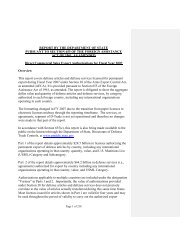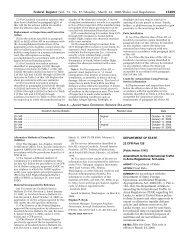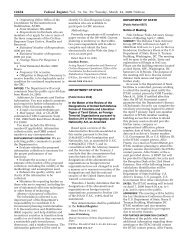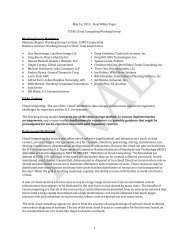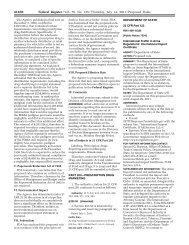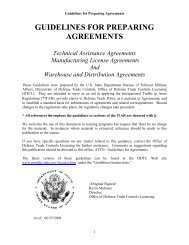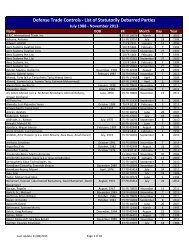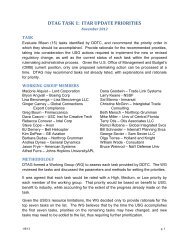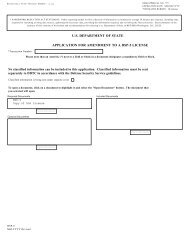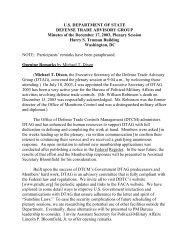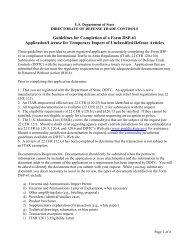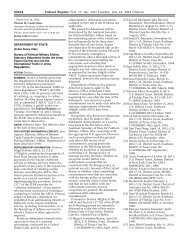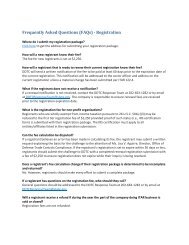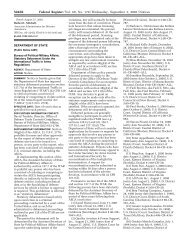Cloud Computing - Directorate of Defense Trade Controls
Cloud Computing - Directorate of Defense Trade Controls
Cloud Computing - Directorate of Defense Trade Controls
You also want an ePaper? Increase the reach of your titles
YUMPU automatically turns print PDFs into web optimized ePapers that Google loves.
The following ideas were discussed within the DTAG:<br />
a. Regulators could decide not to address the <strong>Cloud</strong> in the regulations and continue under the<br />
current regulatory conditions which implicitly either prohibit or restrict widespread use <strong>of</strong> the<br />
<strong>Cloud</strong>.<br />
b. Regulators could set parameters for using <strong>Cloud</strong> Services and <strong>Cloud</strong> Service Providers for ITAR<br />
(and EAR) compliance.<br />
c. Regulators could modify existing authorizations such as a license or exemption to specifically<br />
manage technical data within the <strong>Cloud</strong>.<br />
d. Regulators could redefine the definition <strong>of</strong> “export” to exclude transmission or storage <strong>of</strong><br />
encrypted ITAR controlled data.<br />
e. Regulators could redefine “technical data” to recognize Cipher text (encrypted data) as being<br />
outside the scope <strong>of</strong> the current definition.<br />
The DTAG determined that ideas a and c provided no enhancement or change to the existing methods<br />
being used today. With respect to regulators establishing parameters or standards for <strong>Cloud</strong> users<br />
and/or CSPs, the DTAG surmised that doing so would be outside the purview <strong>of</strong> the regulators. In<br />
addition, standards and parameters to identify key aspects <strong>of</strong> the arrangement such as roles and<br />
responsibilities and obligations upon contract termination should be identified within the Service Level<br />
Agreement (SLA) between the parties. GAO-210-513 and NIST Special Publication 800-144 provide<br />
recommendations on what the SLA should include.<br />
Having ruled out ideas a, b and c, the DTAG focused ideas d and e, considering encryption as the most<br />
viable method for addressing regulatory challenges related to ITAR controlled data being transmitted to<br />
and being stored in the <strong>Cloud</strong>.<br />
It has been suggested that having the mere ability to ‘access’ ITAR controlled data presumes an export.<br />
Establishing a level <strong>of</strong> encryption deemed adequate to protect and secure ITAR controlled data would<br />
protect the <strong>Cloud</strong> user; enable full use <strong>of</strong> the <strong>Cloud</strong> for storage purposes; and protect the data from<br />
unauthorized access and the potential <strong>of</strong> an unintended export.<br />
The user is placing their information in the <strong>Cloud</strong>, without knowing if, when, or where the CSP may<br />
‘move’ their information to balance <strong>Cloud</strong> use. Encrypting ITAR controlled data to an established USG<br />
standard would protect the data from unintended access and unintended export in the event the CSP<br />
were to move it to a server outside <strong>of</strong> the United States. As a result, the DTAG believes that redefining<br />
‘export’ to exclude unclassified, encrypted technical data being transmitted or stored outside <strong>of</strong> the<br />
United States provided that foreign persons are not provided with the access to the decryption tools is<br />
logical.<br />
ITAR controlled data that is encrypted results in ‘Cipher text’, which contains a form <strong>of</strong> the original plain<br />
text, but is unreadable by human or computer without the tools to decrypt it. Based on Cipher text being<br />
unusable and unreadable by human or computer, the DTAG concluded that Cipher text does not meet the<br />
current ITAR definition <strong>of</strong> “technical data” nor is it within the scope <strong>of</strong> the AECA because it is unusable.<br />
In addition, the DTAG went through the analyses <strong>of</strong> determining whether or not Cipher text is subject to<br />
export regulations using the following model and concluded that Cipher text is not subject to the export<br />
regulations.<br />
5



